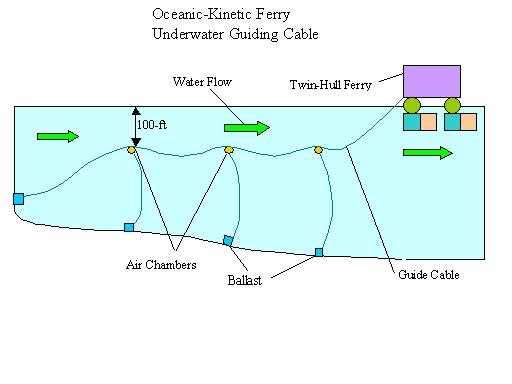The Future Potential for Oceanic Kinetic Ferries
A kinetic ferry uses the kinetic energy of a flowing river as its source of propulsion while crossing a channel, with its path guided by an overhead or submerged cable.
While wind-driven maritime vessels have masts and sails located above the deck, the masts and hydraulic sails of kinetic ferries are submerged below the water line. Kinetic ferries can generate extraordinary starting and pulling power, the result of fresh water and seawater having almost 850 times and 870 times the density of air at sea level.
New Rudder Designs
While earlier rudders depended on water pressing against their surface to exert a steering force, the latest rudders actually use the vacuum effect on the rudder’s shadow side to help exert a powerful force. When a mug full of water is tilted, water will flow down the side of the mug courtesy of the boundary layer effect. In an identical manner, new rudders are design to encourage water to flow along the shadow side, a development that greatly enhances the performance of kinetic ferries that use rudders and underwater sails that provide propulsion.
There is scope to borrow from aeronautical precedent to include a flap on the rudder to further increase the force that can be extracted from a flowing current of water and increase kinetic ferry sailing speed. Some new designs of wind powered boats can extract energy from a crosswind and actually sail at greater speed than the crosswind. Likewise, there may be scope to develop underwater rudder-sails that could propel a kinetic ferry across a channel at slightly greater speed that the speed of the water current that provides the propulsive power.
Rotating Cylinders
A flowing current of water can cause a cylinder mounted on an axle to rotate, and the rotating cylinder redirects the flow direction of the water. There may be scope to design an underwater rudder-sail that includes rotating cylinders that redirect the direction of water flow so as to increase propulsive power.
The location of the rudder-sails submerged below the hull allows for the addition of components that simultaneously increase propulsive power, rudder-sail weight and vessel stability while the strength of the guide cables would determine total overall force generated by the rudder-sails and vessel weight.
Kinetic Turbines
There would also be scope to install a kinetic turbine under the hull of a kinetic ferry to generate electrical power and/or hydraulic power for onboard use and to operate the submerged rudder-sails. Onboard electrical power would provide energy to operate telecommunications equipment as well as vessel lighting requirements for night time sailing.
To minimize need for hydraulic power, there may be scope to attach extended levers with electrically or hydraulically activated small rudders attached to their ends, to change the directional settings of the rudder-sails used for propulsion.
Twill Hull Vessel
A twin hull vessel can offer good stability in waves and cross currents, and the twin hull design allows for rudder-sails to be installed on both hulls. When viewed from above, a staggered approach would allow the full force of the water current to push equally on all rudder-sails to maximize propulsive power. A twin hull design would also allow for installation of necessary structural bracing to further secure the rudder-sails and allow the vessel to sail across the powerful water currents encountered along numerous rivers as well as oceanic channels over distances of a few hundred meters to several kilometers.
Unidirectional Oceanic Channels
However, there are several oceanic straits around the world where water current increases in speed when the tide either flows in or flows out. While some oceanic straits involve bi-directional flow of water current, other channels involve unidirectional flow including:
- Cook Strait, New Zealand
- Foveaux Strait, New Zealand
- Bass Strait, Southern Australia
- East River, New York City
- Florida Strait, Florida – Cuba
- Magellan Strait, Cape Horn (South America)
- North Channel, Northern Ireland – Scotland
- Strait of Dover, UK - France
- Channels between Windward Islands
- Trinidad-Tobago channel
- Channels between Canary Islands
- Yucatan Channel, Mexico - Cuba
- Formosa Strait, Taiwan – China
- Tsushima-Kaikyo, Japan – South Korea
- Channels between Philippine Islands
There are channels that experience substantial traffic, where a submerged ferry that follows the direction of a submerged cable could theoretically sail below the navigation channels of ships that sail through the strait. The ferry design could include submerged sails on both its topside and bottom side, to increase the amount of propulsive energy it could extract from the water current flowing through the channel, allowing for an unmanned vessel to carry freight.
Bidirectional Oceanic Channels
A kinetic vessel that operates across a channel with bidirectional water current would require several modifications to a vessel designed to sail across a unidirectional current. Such modifications would greatly increase the complexity of the kinetic ferry and would likely require duplicate guiding cables. Most channels with bidirectional water current flow are at the entrance of large inlets that undergo major changes of water volume as the tide rises, or mouths of major rivers that undergo a tidal bore that produces a massive upstream surge of water as ocean tide rises.

that matters most
Get the latest maritime news delivered to your inbox daily.
Conclusion
Oceanic kinetic ferries could operate at extremely low cost in terms of fuel and crew requirements. Like schooners and yachts that can sail at an angle of 25-degrees into a wind, kinetic ferries could sail diagonally upstream along a guide cable or even in an arc. Submerged corrosion-resistant cables partially suspended above the seafloor by air chambers would allow kinetic ferries to sail an arc path across a channel with unidirectional water current.
The opinions expressed herein are the author's and not necessarily those of The Maritime Executive.

.JPG)
